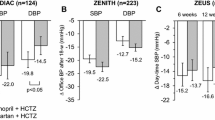Abstract
Objective: The primary objective of this phase IV, nonblind, multicentre study was to determine the antihypertensive effectiveness of irbesartan alone or combined with hydrochlorothiazide (HCTZ) in women with mild to moderate essential hypertension. A secondary objective was to examine the effects of irbesartan on blood lipid levels.
Methods: 188 female patients (94 premenopausal and 94 postmenopausal) with mild to moderate hypertension [seated diastolic blood pressure (SDBP) 95 to 110mm Hg] participated in the study. A 2-week placebo lead-in period was followed by a 24-week active treatment period. Patients initially received 150mg of oral irbesartan once a day, which was titrated to 300 mg/day after 4 weeks in nonresponders. HCTZ 12.5 mg/day was added to treatment after 8 weeks in patients not responding to irbesartan 300 mg/day. The dose of HCTZ could be increased to 25 mg/day after 12 weeks in nonresponders.
Results: 174 patients completed the study, of whom 172 (98.9%) responded to treatment (SDBP <90mm Hg or a reduction of at least 10mm Hg from baseline in SDBP). Mean seated systolic blood pressure and SDBP reductions at 24 weeks were 28.1 and 20.0mm Hg (p = 0.0001), respectively. 88 patients completed the study with irbesartan 150mg, 42 patients with irbesartan 300mg, 18 patients with irbesartan plus HCTZ 300/12.5mg and 26 patients with irbesartan plus HCTZ 300/25mg; response rates were 100, 97.6, 100 and 96.2%, respectively. Total, low density lipoprotein- and high density lipoprotein-cholesterol blood levels were significantly reduced (p < 0.05), but there were no significant changes in blood triglyceride levels or the results of other clinical laboratory tests. Antihypertensive treatment was well tolerated.
Conclusion: Irbesartan, either alone or combined with HCTZ, showed excellent antihypertensive efficacy with a low incidence of adverse events. Hence, irbesartan appears to be a suitable agent for the treatment of hypertension in women.



Similar content being viewed by others
References
Cazaubon C, Gougat J, Bousquet F, et al. Pharmacological characterization of SR 47436, a new nonpeptide AT1 subtype angiotensin II receptor antagonist. J Pharmacol Exp Ther 1993; 265: 826–34
Delisée C, Schaeffer P, Cazaubon C, et al. Characterization of cardiac angiotensin AT1 receptors by [3H]SR 47436. Eur J Pharmacol 1993; 15: 139–44
Gillis JC, Merkham A. Irbesartan: a review of its pharmacodynamic and pharmacokinetic properties and therapeutic use in the management of hypertension. Drugs 1997; 54: 885–902
Pool JL, Guthrie RM, Littlejohn TW, et al. Dose related anti-hypertensive effects of irbesartan in patients with mild to moderate hypertension. Am J Hypertens 1988; 11: 462–70
Kassler-Taub K, Littlejohn T, Elliot W, et al. Comparative efficacy of two angiotensin II receptor antagonists, irbesartan and losartan, in mild to moderate hypertension. Am J Hypertens 1998; 11:445–53
Kochar M, Guthrie R, Triscari J, et al. Matrix study of irbesartan with hydrochlorothiazide in mild to moderate hypertension. Am J Hypertens 1999; 12: 797–805
Rosenstock J, Rossi L, Lin CS, et al. The effects of irbesartan added to hydrochlorothiazide for the treatment of hypertension in patients non-responsive to hydrochlorothiazide alone. J Clin Pharmacol Ther 1998; 23: 433–40
Grossman E, Peleg E, Carroll J, et al. Hemodynamic and humoral effects of the angiotensin II antagonist losartan in essential hypertension. Am J Hypertens 1994; 7: 1041–4
Ogira T, Yoshinaga K. The clinical efficacy and tolerability of the angiotensin II-receptor antagonist losartan in Japanese patients with hypertension. Blood Press 1996; 2 Suppl.: 78–81
Castelli WP. Cardiovascular disease in women. Am J Obstet Gynecol 1990; 158: 1553–60
Bush TL. The epidemiology of cardiovascular disease in postmenopausal women. Ann N Y Acad Sci 1990; 592: 263–71
Rich-Edwards JW, Manson JE, Hennekens CH, et al. The primary prevention of coronary heart disease in women. N Engl J Med 1995; 332: 1758–66
Burt VL, Cuttler JA, Higgins M, et al. Trends in the prevalence, awareness, treatment, and control of hypertension in adult US population: data from the health examination surveys, 1960 to 1991. Hypertension 1995; 26: 60–9
Borges-Yañez SA, Gómez-Danyés H. Uso de los servicios de salud por la población de 60 años y más en México. Salud Publica Mex 1998; 40: 1–11
Sherman LA, Temple R, Merkatz RB. Women in clinical trials: an FDA perspective. Science 1995; 269: 793–5
Agabiti-Rosei E, Ambrosioni E, Pirelli A, et al. Efficacy and tolerability of moexipril and nitrendipine in postmenopausal women with hypertension. Eur J Clin Pharmacol 1999; 55: 185–9
Bhattacharyya GK, Johnson RA. Statistical concepts and methods. 2nd ed. Wisconsin (WI): John Wiley and Sons, 1977
Houston MC, Meador BP, Schipiani LM. Handbook of antihypertensive therapy. 8th ed. Philadelphia (PA): Hanley & Belfus, 1998
Hope S, Brecher P, Chobanian V. Comparison of the effects of AT1 receptor blockade and angiotensin converting enzyme inhibition on atherosclerosis. Am J Hypertens 1999; 12: 28–34
Acknowledgements
This study was supported by Bristol-Myers Squibb, México.
Author information
Authors and Affiliations
Corresponding author
Rights and permissions
About this article
Cite this article
Meaney-Mendiolea, E., Morales-Villegas, E., Vélez-Tello de Meneses, M. et al. Clinical Effectiveness of Irbesartan and Irbersartan plus Hydrochlorothiazide in Women with Mild to Moderate Essential Hypertension. Clin. Drug Investig. 19, 431–439 (2000). https://doi.org/10.2165/00044011-200019060-00005
Published:
Issue Date:
DOI: https://doi.org/10.2165/00044011-200019060-00005




